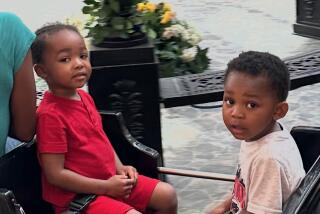Family’s Grief Is Also Part of Living
- Share via
One of my favorite pictures of my children shows them at about 6 weeks, sitting side by side in their infant car seats, crying their eyes out. Except that one is wearing pink and the other blue, you can’t tell them apart.
You can’t tell which is Jessie, a vibrant, robust little girl, and which is Sandy, a little boy who has severe spastic quadriplegia, epilepsy, difficulty breathing and a feeding tube surgically implanted in his stomach.
You can’t tell, from that photo of squalling twins, which baby will walk at 9 months and which never will, which child will talk your ear off and which never will speak.
You can’t tell which baby has less than two years to live.
I have only a few really good pictures of Sandy. His beautiful face was often in spasm, twisted by the cerebral palsy, maybe twisted by pain. I remember sitting one morning at sunrise, after a rough night, gazing at him through the camera lens for half an hour and finally catching an angelic sleep smile. Another prized photo.
Sandy died more than three years ago when he was 22 1/2 months old, exhausted by the effort to breathe, leaving Jessie and me to find a way to make sense of his short life and of our much longer, much fuller lives.
There has been a lot of sadness in those three years. The death of a child is always hard to understand; tougher, perhaps, if one is a child. “Sandy died way, way too soon,” Jessie sometimes says.
Jessie misses Sandy. She knows she has a twin brother in heaven, she knows she was a good sister and good friend to him, and sometimes she includes “and please bless Sandy” in her prayers.
There has been joy in those years too. Early childhood is, after all, a time of exuberant discovery and goofy, giddy laughter, no less for Jessie than for other children.
But in the last three years, Jessie hasn’t seemed to have the child’s usual delight in baby pictures. The pictures that became ever more precious to me brought little solace to her. She had very little interest in pictures of herself and none at all in pictures of Sandy, sometimes identifying him as “baby,” more often acting as if he were not even in a picture.
Then, a few weeks ago, something quietly wonderful happened.
Jessie and I reassembled her cradle, which had been loaned out to other babies and finally returned to provide a home for dolls and stuffed animals. As we finished the job, I decided to get out the very first photo album to see if Jessie wanted to look at pictures of herself, tiny and sleeping in that very same cradle.
And there were, of course, some pictures of Sandy in his cradle and even more pictures of the twins sharing a cradle.
After we’d gone through the album and placed the selected dolls in the cradle, I realized that we’d both been happy looking at that album. Jessie had identified her brother in the pictures and had done so without pain. The tears I often shed while looking at the pictures weren’t stifled; they didn’t happen that day. Instead, we laughed at funny pictures and exclaimed over the tiny fingers and nearly hairless heads.
We still grieve. I suspect I always will, and maybe Jessie will too. But we took a big step that day, looking at the pictures that are part of our lives.
Nearly two years ago I attended a seminar given by the Grief Recovery Institute, and on the day we rebuilt the cradle I understood something I think institute founder John James tries to impart: Recovery from grief is not denial of grief or an end of grief; it is acceptance of it as part of a full, rich and wonderful life.
The tears are not over, nor should they be. But for Jessie and me, Sandy’s legacy is not loss; it is life.


